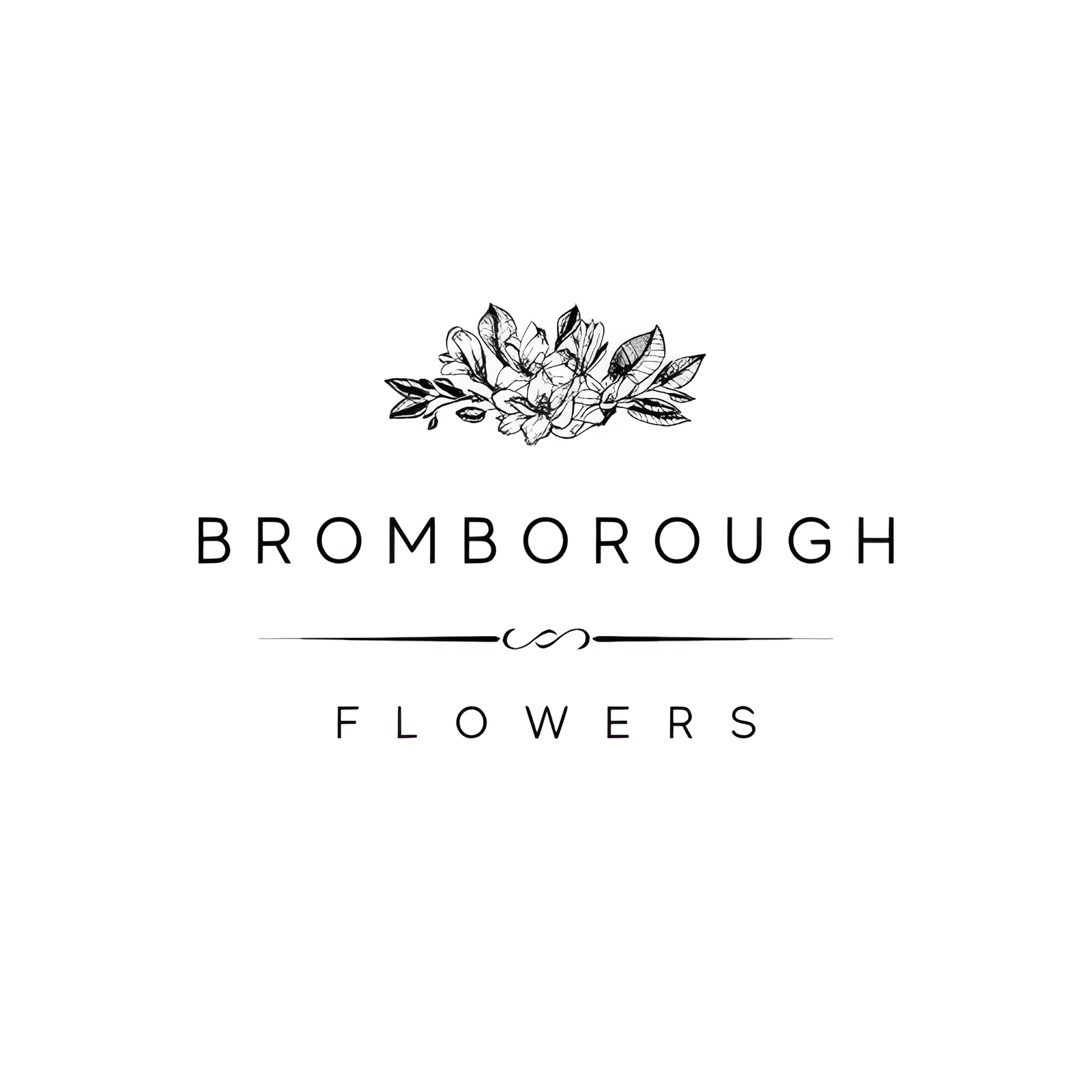Echinacea pods, known for their distinctive circular texture and earthy hues, have become an increasingly popular choice in wedding floral arrangements. Their robust stems provide both structural integrity and impressive longevity, lasting up to two weeks with proper care. Available in green, brown, and burgundy, these pods add a layer of depth and character to bouquets and centerpieces, effortlessly complementing various flower types and color schemes. With their symbolic meanings of strength and healing, echinacea pods are not only affordable and versatile but also imbued with profound significance, making them a thoughtful addition to any wedding celebration.
Flower Overview
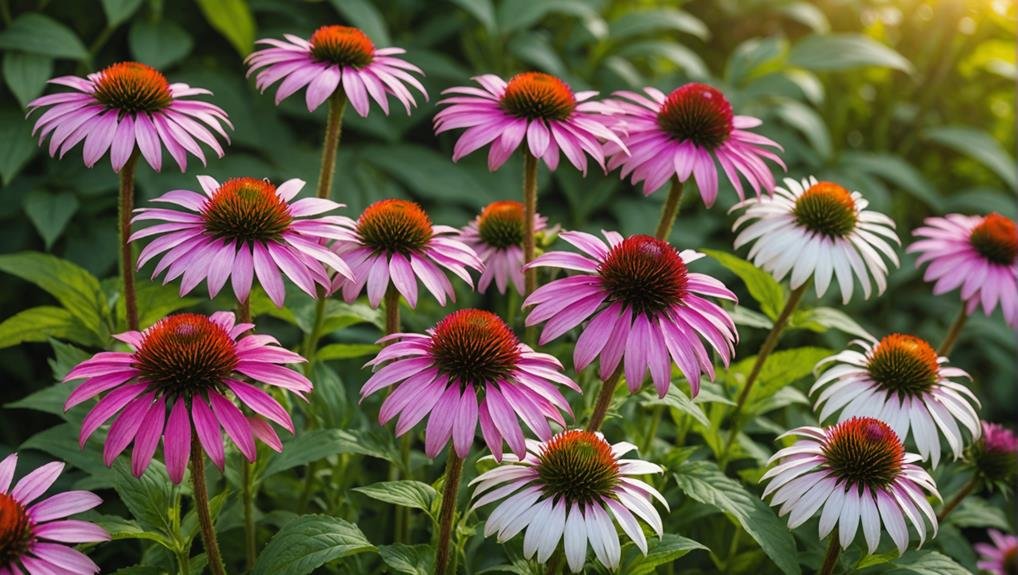
Echinacea pods are a resilient and versatile floral accent known for their unique circular texture and longevity in floral arrangements. These pods are highly valued for their ability to maintain freshness for an extended period, typically lasting between 10 days to two weeks when properly cared for.
One of the key benefits of incorporating Echinacea pods into floral designs is their sturdy stems, which provide structural integrity and ease of arrangement.
To guarantee the maximum freshness of Echinacea pods, it is vital to follow specific care guidelines. Upon receiving the pods, it is recommended to make a fresh cut at the base of each stem before placing them in water immediately. Keeping a watchful eye on water levels is essential, as maintaining adequate hydration is key to prolonging their lifespan. Additionally, it is advisable to store the flowers in a cool, dark area, away from direct sunlight and drafts, which can cause them to wilt prematurely.
Given their versatility and durability, Echinacea pods are a popular choice for wedding arrangements and other special events. Ordering early and specifying the arrival and event dates can further guarantee their best freshness and availability.
Physical Description
Renowned for their distinctive spiky texture and earthy hues, Echinacea pods add a unique visual element to floral arrangements. These pods are celebrated for their robust, tactile presence, which can effortlessly enhance the depth and character of any bouquet or centerpiece. Their spiky appearance offers a striking contrast to softer petals, making them a versatile choice for diverse floral designs.
Echinacea pods are characterized by their sturdy stems, which contribute to their durability. When properly cared for with adequate flower food, these stems can last from 10 days to 2 weeks, ensuring that they maintain their fresh look throughout your event. This longevity makes them an excellent option for weddings and other special occasions, where maintaining the aesthetic appeal of floral arrangements is essential.
Available in various bunch sizes, from 1 to 20 bunches, Echinacea pods provide flexible options to suit different design needs. Their pricing, ranging from $42.99 to $364.99 USD based on quantity, positions them as an affordable yet effective filler for bouquets and centerpieces. This affordability, combined with their unique physical attributes, underscores their popularity in the floral industry.
Available Colour Varieties
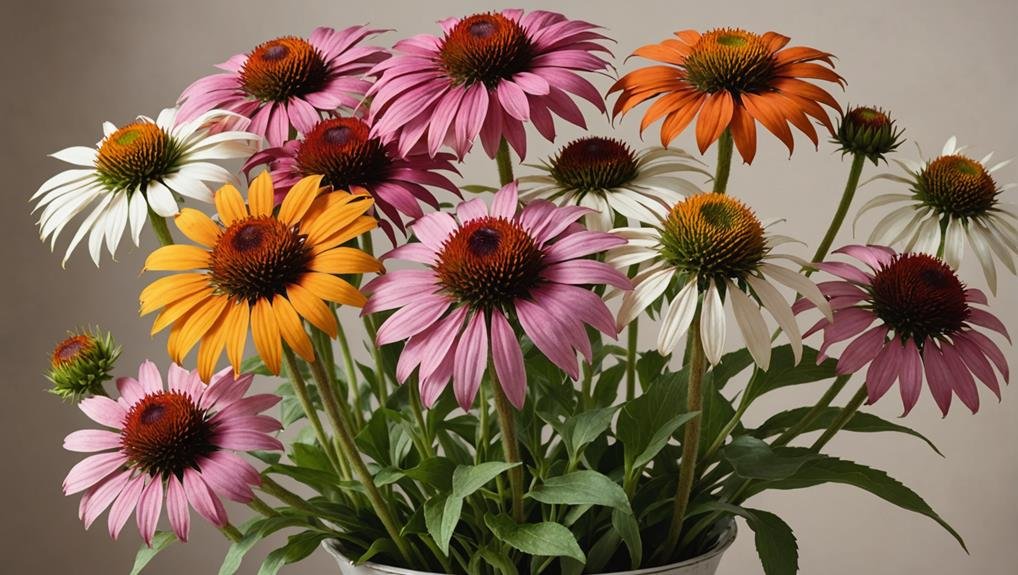
In addition to their distinctive texture and durability, another appealing aspect of echinacea pods is their wide range of colour varieties, including shades of green, brown, and burgundy. These rich hues add depth and visual interest to any floral arrangement, making echinacea pods an ideal choice for weddings. Their versatile colours allow for numerous arrangement options, whether aiming for a natural, rustic look or seeking to add a vibrant accent.
When considering colour pairings, echinacea pods can complement various flower types and hues. For instance, the green shades blend seamlessly with white roses or lilies, offering a fresh and elegant look. Brown pods pair beautifully with sunflowers or daisies, enhancing a rustic or autumnal theme. Burgundy pods, on the other hand, add a sophisticated touch when combined with deep red or purple blooms.
Beyond their aesthetic appeal, the colours of echinacea pods hold symbolic meanings. Green typically symbolizes renewal and growth, making it a fitting choice for new beginnings. Brown signifies stability and comfort, while burgundy represents passion and elegance. By thoughtfully selecting colour varieties and pairings, echinacea pods can enhance both the visual and symbolic aspects of wedding floral arrangements.
Latin Name and Taxonomy
Belonging to the Asteraceae family, the genus Echinacea includes several species, with Echinacea purpurea being one of the most renowned for its use in floral arrangements. The Latin name for Echinacea, derived from the Greek word 'echinos,' meaning hedgehog, refers to the spiny central disk of the flower, which resembles a hedgehog's bristles. This genus is distinguished by its vibrant, daisy-like flowers and its significant role in both horticulture and herbal medicine.
Echinacea purpurea, in particular, has gained popularity not only for its aesthetic appeal in wedding bouquets but also for its medicinal properties. These plants are commonly utilized in herbal remedies, particularly for their immune-boosting effects. The taxonomy of Echinacea is well-documented, with several species recognized within the genus, each contributing unique characteristics to this versatile group of plants.
Here is a brief summary of the key points about Echinacea:
| Column 1 | Column 2 | Column 3 |
|---|---|---|
| Family | Asteraceae | |
| Genus | Echinacea | |
| Greek Origins | 'Echinos' (hedgehog) | Refers to spiny flower head |
| Medicinal Uses | Immune support | Herbal remedies |
This concise overview highlights the essential aspects of Echinacea's Latin name and taxonomy.
Geographical Origins
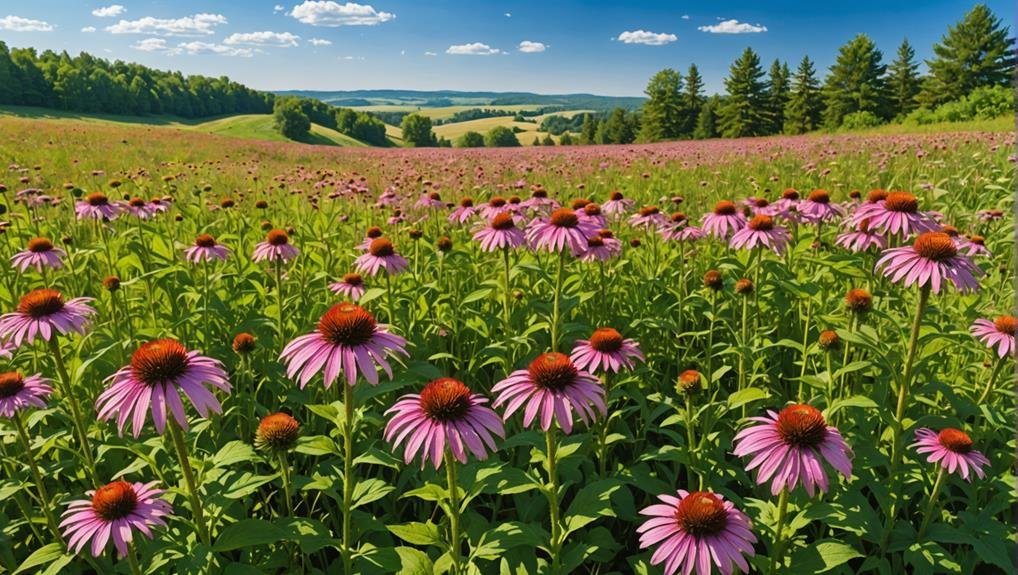
The native range of Echinacea, commonly known as coneflowers, spans from the eastern United States to the western plains, thriving in well-drained soils and full sunlight. This broad plant distribution highlights the adaptability of the plant to diverse environments within North America.
Echinacea's native habitats include prairies, open woodlands, and rocky terrains, where they benefit from abundant sunlight and minimal water retention in the soil.
Three key points about Echinacea's geographical origins are:
- Botanical Distribution: Echinacea is mainly found across North America, particularly in regions like the Midwest and Great Plains. This extensive distribution showcases the plant's versatility and resilience.
- Native Habitats: The natural environments where Echinacea thrives are often characterized by open spaces with good air circulation. These include prairies and grasslands, where the plant's deep root system helps it withstand periods of drought.
- Climate Preferences: Echinacea prefers climates that offer full sun exposure and moderate rainfall. These climate preferences make it an ideal candidate for gardens that mimic its native prairie environment, contributing to its popularity among gardeners seeking low-maintenance, drought-tolerant plants.
Understanding these aspects of Echinacea's geographical origins can enhance appreciation for its role in both natural ecosystems and cultivated landscapes.
Season Availability
Echinacea's season availability peaks during the late summer and early fall, particularly from July to September. This period is when the flowers are at their most vibrant and abundant, making them an excellent choice for weddings and other special events.
The peak availability of echinacea pods is in August, which is ideal for floral arrangements that need a touch of rustic elegance.
When considering echinacea for your event, it's important to consult with your floral provider to confirm local availability, as this can vary based on regional growing conditions. For those interested in incorporating this flower into their own gardens, some planting tips include ensuring well-drained soil and full sun exposure to maximize bloom quality and duration.
Preservation techniques are essential to extending the life of echinacea blooms. Cutting the stems at an angle and placing them in fresh water can help maintain their freshness. Additionally, floral preservatives can be added to the water to further prolong their beauty.
DIY bouquet ideas featuring echinacea can add a unique and personal touch to any event. Combining echinacea with other seasonal flowers and greenery creates visually striking and memorable arrangements that embody the essence of late summer and early fall.
Growing Conditions
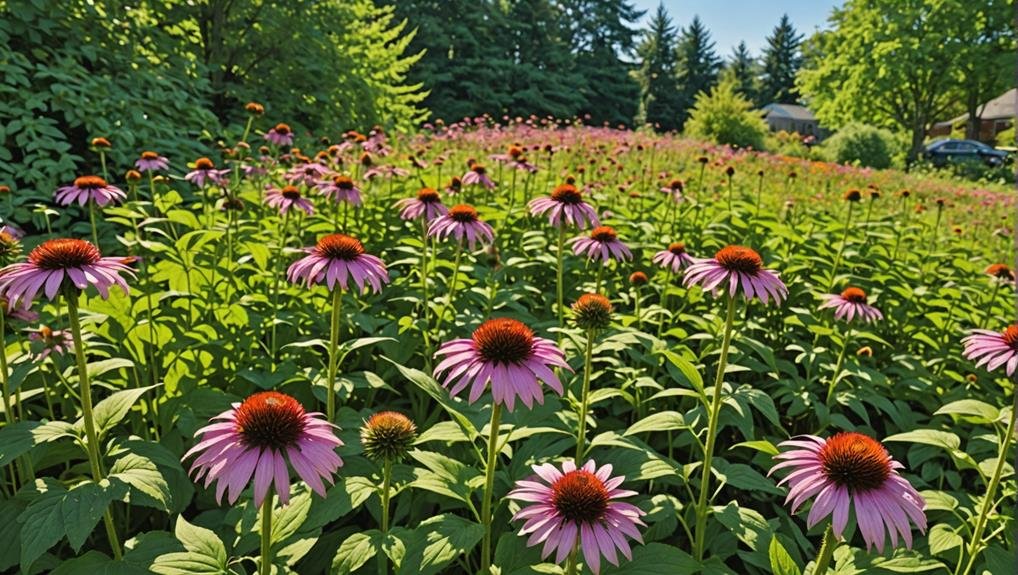
Optimal growth of echinacea plants necessitates full sun to partial shade, in addition to well-draining soil that maintains a pH level between 6.0 and 7.0. These conditions are vital to support the plant's robust development and vibrant blooms. Echinacea, commonly known as coneflowers, are highly adaptable and can thrive in a variety of soil types, making them a versatile choice for gardeners.
To achieve the best growth, consider the following key points:
- Watering Frequency and Soil Type:
While echinacea plants are drought-tolerant once established, they benefit from regular watering during their initial growth phase. It is important to plant them in well-draining soil to prevent waterlogging, which can lead to root rot.
- Sunlight Requirements and pH Levels:
Echinacea thrives in environments that provide full sun to partial shade. Ensuring the soil maintains a pH level between 6.0 and 7.0 will create favorable conditions for nutrient absorption and overall plant health.
- Pollinator Attraction and Drought Tolerance:
Echinacea is known for attracting pollinators such as bees and butterflies, making it a beneficial addition to any garden. Its drought tolerance further highlights its suitability for various climates, reducing the need for frequent watering once the plant is well-established.
Cultural Significance
How has echinacea, often revered for its robust blooms and medicinal qualities, come to symbolize strength and health across various cultures?
Echinacea, commonly known as coneflowers, holds a prominent place in both historical and contemporary cultural contexts. Its healing properties and symbolic meanings have been cherished for centuries. In Native American traditions, echinacea was extensively used for its medicinal benefits, particularly in treating infections and enhancing the immune system. This deep-rooted association with health and vitality has imbued the flower with significant spiritual importance.
The folklore surrounding echinacea is rich and varied, often highlighting its role in protection and resilience. Many cultures believe that the vibrant colors of echinacea petals can attract positive energy and ward off negative influences, further emphasizing its symbolic meanings of strength and healing. Medicinal folklore frequently references echinacea as a potent remedy, reinforcing its status as a symbol of robustness and endurance.
The enduring appeal of echinacea's unique appearance and its hardy nature make it a lasting emblem of longevity and vitality. This cultural reverence for echinacea's attributes ensures its ongoing popularity and relevance in various traditions and practices around the world.
Typical Use in Weddings
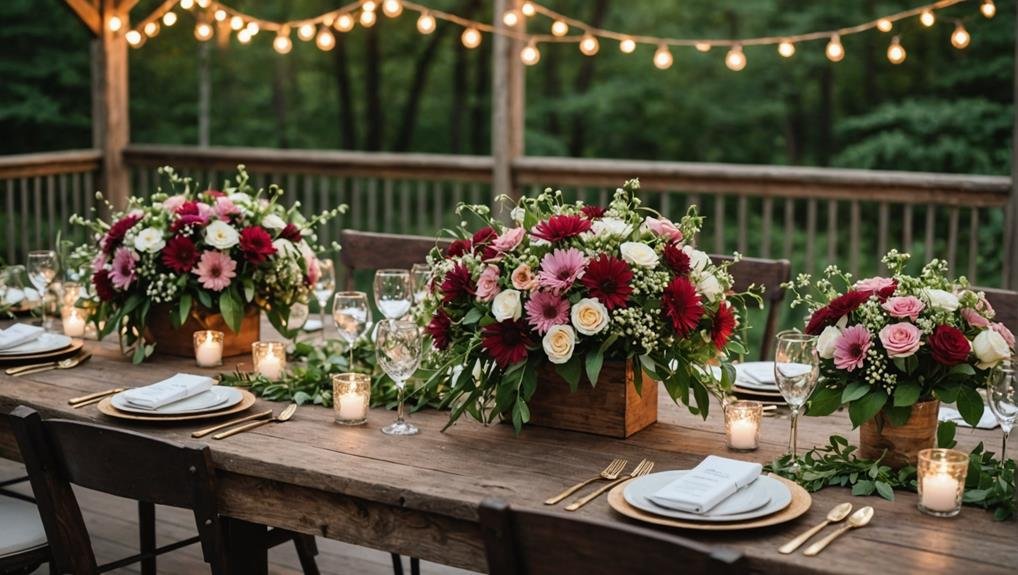
Echinacea pods are increasingly popular in wedding bouquets and arrangements due to their unique texture and longevity. Known for their sturdy stems and ability to last from 10 days to 2 weeks, echinacea pods provide a reliable and visually appealing option for wedding florals. Their circular texture adds depth and interest, making them a favored choice among floral designers and DIY enthusiasts alike.
Incorporating echinacea into wedding decor can be both stylish and practical. Here are three common uses:
- Echinacea Arrangements and Floral Trends: Echinacea pods are often utilized in contemporary floral trends, providing a modern and organic touch to both bouquets and larger installations. Their distinctive look makes them an excellent choice for couples seeking a unique aesthetic.
- Echinacea Bouquet and DIY Ideas: For those interested in creating their own wedding florals, echinacea pods are an excellent DIY idea. Their availability in various bunch sizes, ranging from 1 to 20, offers flexibility for different design needs and scales.
- Echinacea Centerpiece and Budget-Friendly Options: As a budget-friendly option, echinacea pods can be purchased in bulk, with prices ranging from $42.99 to $364.99 USD. This makes them ideal for crafting stunning centerpieces without compromising on quality or style.
Alternative Flower Types
When planning wedding florals, considering alternative flower types such as roses, peonies, dahlias, and hydrangeas can provide diverse textures and colors to enhance the overall aesthetic. These alternatives offer a variety of hues, forms, and sizes, making them versatile choices for any wedding theme.
Roses, with their timeless appeal, are available in numerous colors and can convey different meanings, making them a classic option for bouquet alternatives. Peonies, known for their lush and romantic look, come in shades ranging from soft pastels to bold, vibrant hues, making them ideal for centerpiece options. Dahlias and hydrangeas, on the other hand, are excellent for filling space in floral designs and can serve as focal points, adding depth and interest to arrangements.
Below is a comparison table showcasing these alternative flower types:
| Flower Type | Bouquet Alternatives | Centerpiece Options |
|---|---|---|
| Roses | Classic choice | Wide range of colors |
| Peonies | Romantic, lush look | Soft pastels to bold hues |
| Dahlias | Versatile, varied | Focal points |
| Hydrangeas | Space fillers | Depth and interest |
Incorporating these flowers into your wedding decor opens up a world of decorative possibilities, ensuring that your floral arrangements are as unique and memorable as your special day.
